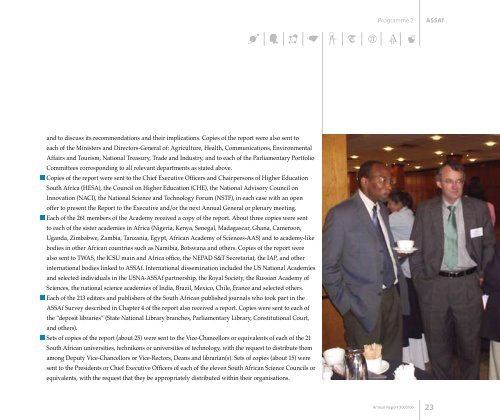Academy of Science South Africa 2005/6 Annual Report
Academy of Science South Africa 2005/6 Annual Report
Academy of Science South Africa 2005/6 Annual Report
- No tags were found...
You also want an ePaper? Increase the reach of your titles
YUMPU automatically turns print PDFs into web optimized ePapers that Google loves.
Programme 2ASSAfand to discuss its recommendations and their implications. Copies <strong>of</strong> the report were also sent toeach <strong>of</strong> the Ministers and Directors-General <strong>of</strong>: Agriculture, Health, Communications, EnvironmentalAffairs and Tourism, National Treasury, Trade and Industry, and to each <strong>of</strong> the Parliamentary PortfolioCommittees corresponding to all relevant departments as stated above.Copies <strong>of</strong> the report were sent to the Chief Executive Officers and Chairpersons <strong>of</strong> Higher Education<strong>South</strong> <strong>Africa</strong> (HESA), the Council on Higher Education (CHE), the National Advisory Council onInnovation (NACI), the National <strong>Science</strong> and Technology Forum (NSTF), in each case with an open<strong>of</strong>fer to present the <strong>Report</strong> to the Executive and/or the next <strong>Annual</strong> General or plenary meeting.Each <strong>of</strong> the 261 members <strong>of</strong> the <strong>Academy</strong> received a copy <strong>of</strong> the report. About three copies were sentto each <strong>of</strong> the sister academies in <strong>Africa</strong> (Nigeria, Kenya, Senegal, Madagascar, Ghana, Cameroon,Uganda, Zimbabwe, Zambia, Tanzania, Egypt, <strong>Africa</strong>n <strong>Academy</strong> <strong>of</strong> <strong>Science</strong>s-AAS) and to academy-likebodies in other <strong>Africa</strong>n countries such as Namibia, Botswana and others. Copies <strong>of</strong> the report werealso sent to TWAS, the ICSU main and <strong>Africa</strong> <strong>of</strong>fice, the NEPAD S&T Secretariat, the IAP, and otherinternational bodies linked to ASSAf. International dissemination included the US National Academiesand selected individuals in the USNA-ASSAf partnership, the Royal Society, the Russian <strong>Academy</strong> <strong>of</strong><strong>Science</strong>s, the national science academies <strong>of</strong> India, Brazil, Mexico, Chile, France and selected others.Each <strong>of</strong> the 213 editors and publishers <strong>of</strong> the <strong>South</strong> <strong>Africa</strong>n published journals who took part in theASSAf Survey described in Chapter 4 <strong>of</strong> the report also received a report. Copies were sent to each <strong>of</strong>the “deposit libraries” (State National Library branches, Parliamentary Library, Constitutional Court,and others).Sets <strong>of</strong> copies <strong>of</strong> the report (about 25) were sent to the Vice-Chancellors or equivalents <strong>of</strong> each <strong>of</strong> the 21<strong>South</strong> <strong>Africa</strong>n universities, technikons or universities <strong>of</strong> technology, with the request to distribute themamong Deputy Vice-Chancellors or Vice-Rectors, Deans and librarian(s). Sets <strong>of</strong> copies (about 15) weresent to the Presidents or Chief Executive Officers <strong>of</strong> each <strong>of</strong> the eleven <strong>South</strong> <strong>Africa</strong>n <strong>Science</strong> Councils orequivalents, with the request that they be appropriately distributed within their organisations.<strong>Annual</strong> <strong>Report</strong> <strong>2005</strong>/0623









![National Research Foundation Annual Report 2008 / 2009 [Part 2]](https://img.yumpu.com/49774036/1/177x260/national-research-foundation-annual-report-2008-2009-part-2.jpg?quality=85)






